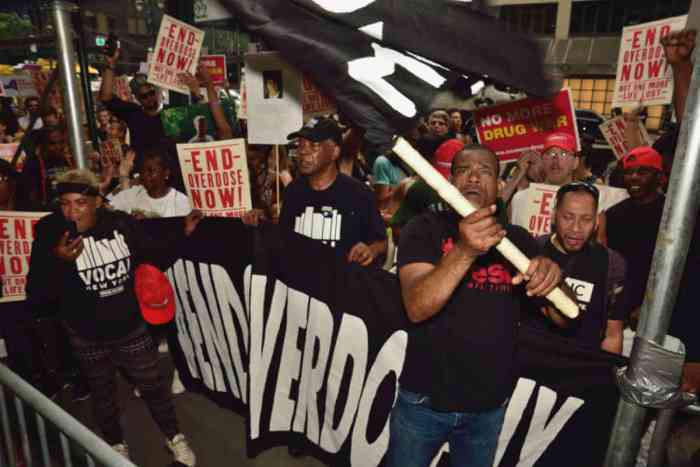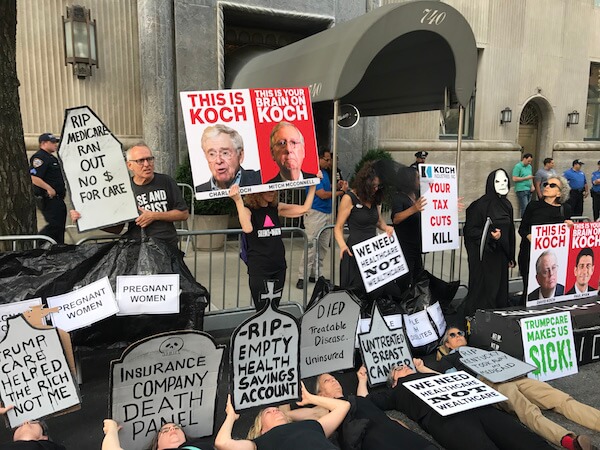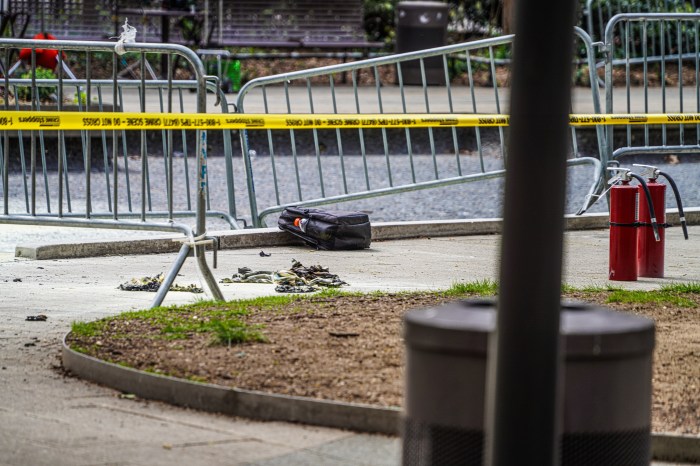ILLUSTRATION BY MICHAEL SHIREY
Leading AIDS group are pressing an ambitious plan on the city and state they say will end the AIDS epidemic in New York by 2020.
“This isn’t pie in the sky,” said Daniel Tietz, executive director of ACRIA, an AIDS services group, at a March 12 meeting at the Lesbian, Gay, Bisexual & Transgender Community Center. “This is basic science and we actually know how to do it.”
The plan envisions expanding HIV testing and quickly linking those who test positive to care and treatment. Early treatment pays health benefits to those who are HIV-positive. In addition, if they adhere to a treatment regimen, they are less infectious and far less likely to infect others. That second part of the equation is known within the AIDS field as “treatment as prevention.”
Advocates also propose expanding the availability of pre-exposure prophylaxis (PrEP), or giving uninfected people anti-HIV drugs to prevent infection, and post-exposure prophylaxis (PEP), or giving anti-HIV drugs to someone immediately after they are exposed to HIV to stop infection from taking hold.
In addition to these biomedical interventions, the groups want to address the social factors, such as homelessness and poverty, that are associated with increased risk for HIV infection and with moving from an HIV diagnosis to AIDS.
New York State Health Commissioner Nirav Shah endorsed the feasibility of a plan to end the AIDS epidemic by 2020. | NEW YORK STATE DEPARTMENT OF HEALTH
While there are separate plans for the city and state, they are largely the same. Some features are things that AIDS groups have sought for years. Their reliance almost entirely on biomedical interventions is shown by a single reference to condoms, saying that the state should enact a law barring their use as evidence in prostitution trials.
Housing Works, an AIDS services group, and the Treatment Action Group, a leading advocacy group that is not typically involved in state and local policy matters, are leading the effort. On March 19, 33 gay and AIDS groups and leading elected officials rallied in Albany in support of the plan.
The groups want a state task force to formally write the plan, then the city and state will implement it. What is surprising is that there is no political resistance as of yet. While Governor Andrew Cuomo has not publicly backed the plan, Dr. Nirav Shah, the state health commissioner, endorsed it at a January 9 event at the World Bank.
“What I would like to say, which I may get in trouble for, I think that New York State can commit to an end of the AIDS epidemic by 2020,” Shah said.
In New York, which had roughly 3,400 new HIV diagnoses in 2013, Shah said, success would be “730 new infections or fewer” a year and that 95 percent of people who are newly diagnosed with HIV do not progress to AIDS.
“That is an achievable goal for New York,” Shah said. “I think it’s a stretch goal… New York can lead the way. This can be a reality for the rest the country if not by 2020, shortly thereafter.”
The state’s $54 billion Medicaid program is currently negotiating with anti-HIV drug manufacturers to get them to reduce what they charge the state, something that is required to expand treatment.
City Health Commissioner Mary Bassett has not yet met with advocates regarding the 2020 plan, but has acknowledged that regimen adherence is a key issue for the success of PrEP. | GAY CITY NEWS
The majority of new infections in New York are in New York City, so the city’s participation is a necessity if the plan is to succeed.
Like Cuomo, Mayor Bill de Blasio has not publicly supported the plan, but advocates had supportive responses in meetings with Lilliam Barrios-Paoli, the deputy mayor for health and human services, and senior staff in the city’s health department. They have yet to met with Dr. Mary Bassett, the city’s health commissioner.
The politics aside, there are considerable impediments to achieving the plan’s goal of reducing new HIV infections, not the least of which is reducing them among gay and bisexual men.
“We do have real challenges among men having sex with men,” Shah said. “We have hot spots that are not improving.”
PrEP and PEP have proven effectiveness. PEP, which must be initiated within 72 hours of potential HIV exposure, has not been widely publicized in the city nor is it widely available, and the plan seeks to change that.
Americans have been slow to adopt PrEP. Between January 2011 and March 2013, 1,774 people started PrEP, according to Gilead Sciences, the company that markets Truvada, the PrEP drug. Gilead has not updated this data since last year. In PrEP studies, most of the participants who were supposed to be taking the drug did not adhere to the daily dosing schedule.
When Bassett’s appointment was announced at a January 16 press conference, she acknowledged that the general response to PrEP was not enthusiastic.
“It’s been the experience that the uptake of pre-exposure prophylaxis has been quite low, and I think that signals the fact that we have to talk to affected communities to try and understand what’s important to them, what they value,” she said.
Following that press conference, she said, “The problem with drugs is you have to take them. I know the evidence is good, I just have questions about relying on drugs.”
Some data suggest that treatment as prevention could also face obstacles in a neighborhood such as Chelsea-Clinton in Manhattan that has high HIV prevalence and high rates of unsafe sex among gay men.
A 2013 study averaged the 2008 viral load –– a measure of the amount of virus in a person’s blood –– among HIV-positive people in different New York neighborhoods. Chelsea-Clinton had the lowest community viral load among the six neighborhoods studied, at 18,243 copies per milliliter of blood. In 2008, however, Chelsea-Clinton had the highest rate of new HIV diagnoses in the city, at 167.5 per 100,000 people. The rate citywide was 47.6 per 100,000 people. So, despite lower viral loads in the neighborhood, infection rates remain relatively high.
Treatment as prevention only works if people adhere to the drug schedule and some people with HIV struggle with adherence due to side effects, drug and alcohol problems, or other issues.
In 2008, 35 percent of newly diagnosed HIV infections in the city had testing for anti-HIV drug resistance done within three months of diagnosis and 11.1 percent of the tests showed HIV drug resistance that had been transmitted to them. In 2012, half of the newly diagnosed HIV infections in the city had such testing done within three months and 15.6 percent of the tests showed transmitted drug resistance.
The groups are arguing that if all the biomedical interventions are deployed at the same time in the same place along with addressing social factors, that will overcome the behaviors that defeat interventions that alone are less than 100 percent effective.
“If we get the governor and the mayor to lead in this way, it will lead to success,” Tietz said. “It will be game-changing if New York goes down this road.”




































